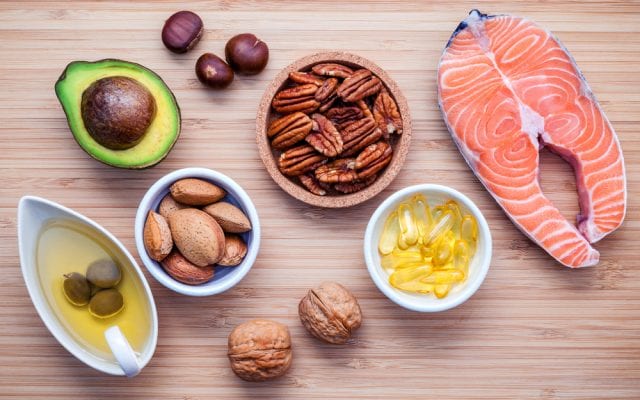
Many people take a daily multi-vitamin to ensure that they are getting enough of the essential vitamins and minerals they need each day. Although it’s recommended to get the bulk of daily nutrients from food, supplements can help pick up the slack when nutritious meals fall short. These are five of the best vitamins to take regularly to promote good joint health.
1. Fish Oil
The omega-3 fatty acid contained in fish oil pills is often associated with a healthy heart and glowing skin.1 However, it also plays a role in supporting the joints. Fatty acids help to prevent certain enzymes from damaging the joints and is known to help reduce inflammation.2,3 This is a particularly good supplement to take if one suffers from knee pain or have rheumatoid arthritis. It is also possible to get omega-3 fatty acids from fish, avocados, nuts, and seeds.4
2. Calcium
Calcium is a familiar nutrient that is closely tied to bone and joint health.5 It is the nutrient associated with helping to form the bones and teeth and keep them strong.7,8 Calcium pills can be effective in reducing joint inflammation and pain, especially in the knee joints. Dark leafy greens, milk, yogurt, and broccoli are examples of foods high in calcium.6,7,8 As a general rule, women are more likely to need to supplement with calcium than men.6,8
3. Vitamin D
Studies have shown that people with low levels of vitamin D tend to suffer from joint pain more frequently. Vitamin D also assists in the body’s absorption of calcium.5,9 By taking this vitamin, one can help strengthen the bones and joints. It is possible to find vitamins that contain both calcium and vitamin D. Vitamin D can also be obtained through fortified milk and pure sunlight.
4. Glucosamine
Glucosamine is a lesser-known nutrient that may also be helpful to joint pain sufferers.10 This one is often recommended for knee joints because it helps to rebuild bone and prevent wear of the cartilage. Glucosamine may also help with inflammation that accompanies joint pain.11 This is a good supplement to know for older adults with osteoarthritis because glucosamine levels tend to decline with age. It may take several months to see improvements in joint conditions after starting to take supplements like these.
5. Chondroitin
Chondroitin is typically used alongside glucosamine to help prevent joint pain and rebuilt cartilage.11 These two nutrients are often found in the same supplements. Chondroitin is sometimes recommended to individuals with osteoarthritis because it has shown to help slow the progression of the disease.
Other Prevention Strategies
Like exercising,12,13 getting enough rest,14 and good ergonomics,15 taking vitamins is a preventative measure to help the body fight off joint pain before it strikes. Prevention strategies can go a long way in keeping the joints mobile, flexible, and pain-free.
However, joint pain sufferers should always discuss new supplements with a doctor to ensure they are necessary and won’t negatively interact with other medications taken. Fortunately, when healthy diet and lifestyle choices are paired with fast-acting joint pain relief creams like JointFlex, individuals with arthritis can continue to enjoy the activities they love.
References for Top 5 Vitamins for Healthy Joints
- Omega-3s: In depth. National Center for Complementary and Integrative Health. Retrieved October 17, 2018 from https://nccih.nih.gov/health/omega3/introduction.htm.
- Kremer, J. M., Lawrence, D. A., Petrillo, G. F., Litts, L. L., Mullaly, P. M., Rynes, R. I., Stocker R. P., et al. (1995 August). Effects of high-dose fish oil on rheumatoid arthritis after stopping nonsteroidal anti-inflammatory drugs. Clinical and immune correlates. Arthritis and Rheumatism, 38, 1107-1104. Retrieved October 18, 2018 from National Center of Biotechnology Information https://www.ncbi.nlm.nih.gov/pubmed/7639807.
- Maroon, J. C., & Bost, J. W. (2006 April). Omega-3 fatty acids (fish oil) as an anti-inflammatory: an alternative to nonsteroidal anti-inflammatory drugs for discogenic pain. Surgical Neurology, 65, 326-331. Retrieved from National Center of Biotechnology Information https://www.ncbi.nlm.nih.gov/pubmed/16531187.
- Omega-3 fatty acids: Fact sheet for consumers. National Institutes of Health: Office of Dietary Supplements. Retrieved October 18, 2018 from https://ods.od.nih.gov/factsheets/Omega3FattyAcids-Consumer/.
- Two keys to strong bones: Calcium and Vitamin D. Harvard Health Publishing. Retrieved October 18, 2018 from https://www.health.harvard.edu/womens-health/two-keys-to-strong-bones-calcium-and-vitamin-d.
- Calcium. Better Health Channel. Retrieved October 18, 2018 from https://www.betterhealth.vic.gov.au/health/HealthyLiving/calcium.
- Calcium. MedlinePlus. Retrieved October 18, 2018 from https://medlineplus.gov/calcium.html.
- Calcium: Fact sheet for consumers. National Institutes of Health: Office of Dietary Supplements. Retrieved October 18, 2018 from https://ods.od.nih.gov/factsheets/Calcium-Consumer/.
- Vitamin D: Fact sheet for health professionals. National Institutes of Health: Office of Dietary Supplements. Retrieved October 18, 2018 from https://ods.od.nih.gov/factsheets/VitaminD-HealthProfessional/.
- Glucosamine Sulfate. MedlinePlus. Retrieved October 18, 2018 from https://medlineplus.gov/druginfo/natural/807.html.
- Glucosamine and Chondroitin for Osteoarthritis. National Center for Complementary and Integrative Health. Retrieved October 18, 2018 from https://nccih.nih.gov/health/glucosaminechondroitin.
- Arthritis. Centers for Disease Control and Prevention. Retrieved October 18, 2018 from https://www.cdc.gov/arthritis/about/key-messages.htm.
The secret to joint pain relief — exercise. Harvard Health Publishing. Retrieved October 18, 2018 from https://www.health.harvard.edu/healthbeat/the-secret-to-joint-pain-relief-exercise. - DeVries, C. (2016 February 24). When I’m in pain, should I exercise or rest? Veritas Health. Retrieved October 18, 2018 from https://www.arthritis-health.com/blog/when-im-pain-should-i-exercise-or-rest.
- Lowe, B. D., Baker, B. A., & Grosch, J. Joint pain in the workplace. NIOSH Science Blog. https://blogs.cdc.gov/niosh-science-blog/2012/10/29/joint-pain/.
